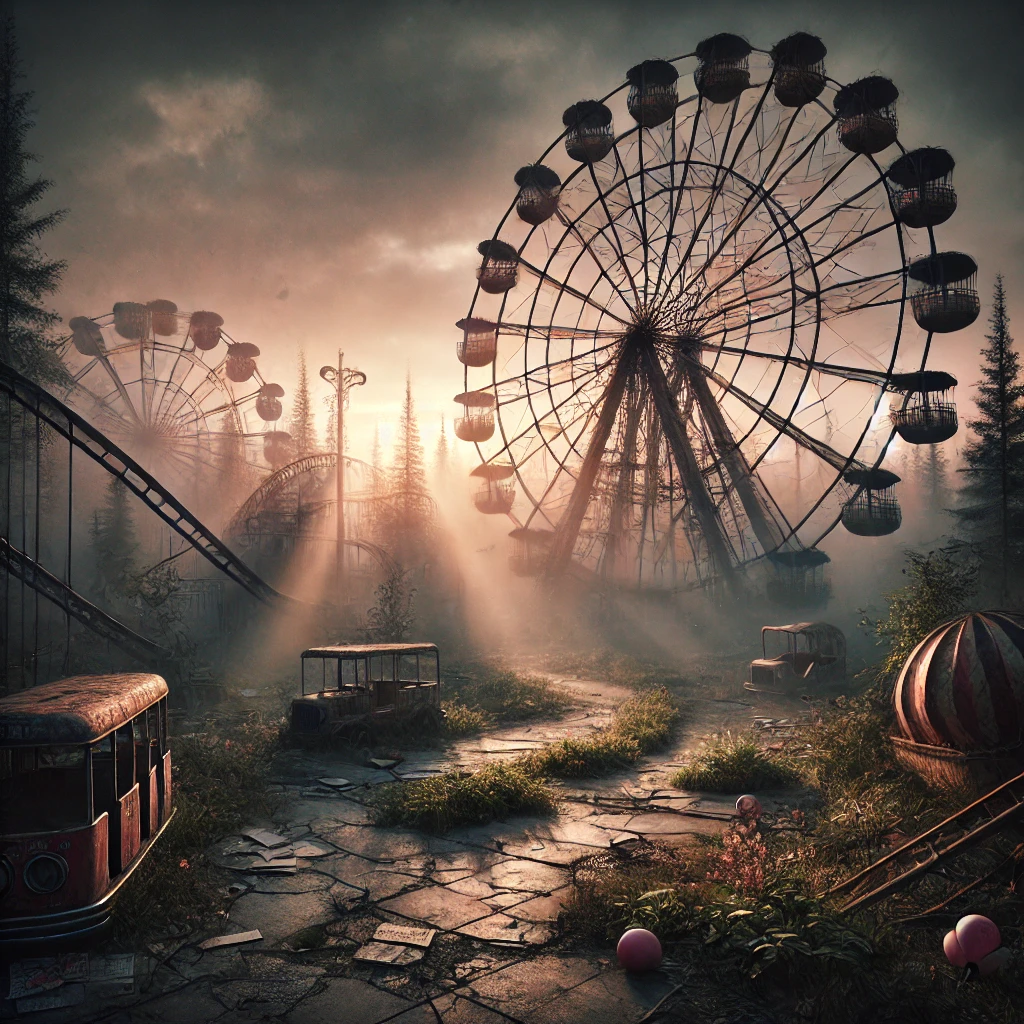
Abandoned amusement parks are unique spaces where the vibrancy of the past collides with the haunting silence of the present. These parks, once filled with joy and laughter, now stand as eerie monuments to a bygone era. Overgrown vegetation, rusting rides, and faded colors evoke a mixture of nostalgia and melancholy, making them irresistible to artists, photographers, and storytellers. Their haunting beauty provides a powerful canvas for exploring themes of transformation, decay, and impermanence.
What makes these parks so compelling is the stark contrast they represent. They were once designed to inspire wonder and happiness, yet in abandonment, they exude mystery and desolation. This juxtaposition invites reflection, reminding us of the fleeting nature of human creations. Artists have long drawn inspiration from such ruins, and abandoned amusement parks offer a distinctly modern iteration of this fascination, blending the familiar with the surreal.
Artistic interpretations of these spaces span photography, painting, filmmaking, and even digital recreations. Each medium brings a new perspective, turning rusted Ferris wheels and crumbling roller coasters into profound symbols of change and resilience. These parks also provide insight into larger societal themes, such as the effects of consumerism, urban neglect, and natural disasters on human-made environments.
The allure of abandoned amusement parks is universal, transcending cultural and geographic boundaries. Whether in the shadow of a forgotten Ferris wheel or the stillness of an overgrown carousel, these spaces offer an eerie yet captivating beauty that resonates deeply with the human experience.
The Rise and Fall of Amusement Parks
Amusement parks have a rich history, originating as places of joy and escape for a burgeoning middle class in the late 19th century. Iconic early parks like Coney Island in New York provided thrilling rides and attractions, setting the stage for a global industry. As technology advanced, these parks became more elaborate, culminating in the groundbreaking creation of Disneyland in 1955. This park revolutionized the concept of entertainment, blending fantasy with reality and creating fully immersive experiences.
Despite their popularity, many parks could not sustain their success. Smaller, independent venues struggled to compete with corporate giants like Disney and Universal, which dominated the industry. Rising operational costs, changing consumer tastes, and local economic struggles forced many parks to close. For example, Nara Dreamland in Japan, modeled after Disneyland, shut down in 2006 after dwindling attendance. The collapse of such parks marks the transition from a golden age of amusement to a period of decline.
Natural disasters and tragedies have also played a role in the abandonment of several parks. The Pripyat Amusement Park, situated near the Chernobyl Nuclear Power Plant, never officially opened due to the catastrophic meltdown in 1986. Similarly, Hurricane Katrina destroyed Six Flags New Orleans in 2005, leaving it a flooded and irreparable ruin. These parks now stand as haunting reminders of human vulnerability to both economic and environmental forces.
Today, the remnants of these parks are scattered across the globe, each telling a unique story of rise and fall. Their decayed states offer a stark reflection of the impermanence of joy and the relentless passage of time, themes that deeply resonate with artists and onlookers alike.
Why Are We Drawn to Abandoned Spaces?
The human fascination with abandoned spaces stems from their ability to evoke a mix of emotions, from nostalgia to curiosity. These places, once vibrant and full of life, now serve as reminders of impermanence and change. Psychologists suggest this attraction is tied to “ruin lust,” a term describing the aesthetic appeal of decay. Abandoned amusement parks, with their rusting rides and overgrown pathways, embody this concept in a way that is both eerie and enchanting.
Amusement parks are particularly poignant because of what they symbolize: childhood joy, innocence, and collective memory. When these spaces fall into disrepair, they create an emotional dissonance that is both unsettling and captivating. The juxtaposition of happiness and desolation resonates deeply, making us reflect on the fleeting nature of human experiences. This is why so many artists, photographers, and explorers find inspiration in these haunting places.
These spaces also spark curiosity and a sense of mystery. Each broken ride and peeling sign carries a story, inviting speculation about the lives of those who once visited. Why were these parks abandoned? What memories do they hold? These unanswered questions create a narrative that captivates the imagination, offering endless possibilities for artistic interpretation.
Abandoned spaces challenge us to confront themes of loss and transformation. They remind us that nothing is permanent, and even the most joyous creations are subject to the ravages of time. This bittersweet truth is part of what makes them so compelling to explore, document, and immortalize through art.
Artistic Interpretations of Abandoned Amusement Parks
Artists have long been drawn to the haunting beauty of abandoned amusement parks, transforming these decayed spaces into profound works of art. Photographers, in particular, excel at capturing the eerie stillness of these places. Seph Lawless, a prominent urban exploration photographer, has documented numerous abandoned parks, showcasing their surreal beauty. His work highlights the interplay of light, shadow, and texture, turning rust and rubble into striking visual compositions.
Painters and illustrators also find inspiration in these spaces, using them as backdrops for symbolic and surreal imagery. The decaying rides and overgrown landscapes become metaphors for time’s passage and the resilience of nature. Through vibrant yet unsettling color palettes, these artworks invite viewers to explore the themes of impermanence and transformation. The contrast between the vibrant dreams these parks once embodied and their current state of decay creates a powerful narrative.
Filmmakers and video game designers have embraced abandoned amusement parks as evocative settings for their stories. Movies like Zombieland and Spirited Away feature these locations as central to their narratives, using their haunting charm to explore themes of loss and renewal. Similarly, video games such as The Last of Us and Silent Hill immerse players in eerie recreations of abandoned parks, heightening the emotional impact of their stories.
Across all artistic mediums, abandoned amusement parks serve as a rich source of inspiration. They offer a unique blend of beauty and decay, challenging artists and audiences to confront themes of change, memory, and resilience. By preserving these spaces through art, creators ensure their stories live on, captivating new generations with their haunting allure.
Photography as a Window into Decay
Photography has become one of the most prominent ways to document and explore the haunting beauty of abandoned amusement parks. Through their lenses, photographers capture the interplay of light, shadow, and texture that defines these spaces. Each photograph tells a story, showcasing the eerie stillness of rusted roller coasters, empty ticket booths, and overgrown pathways. These images highlight the transformation of human-made structures as nature reclaims them, creating a powerful visual narrative.
Seph Lawless is a renowned photographer who has made abandoned amusement parks a central theme of his work. His photographs reveal the surreal beauty of these spaces, blending haunting details with a sense of mystery. Lawless uses techniques like long exposure and natural light to emphasize the textures of decay, such as peeling paint and crumbling wood. His work not only preserves these parks but also evokes emotions of nostalgia and melancholy, inviting viewers to imagine the lives once lived in these places.
The popularity of urban exploration photography has also brought attention to lesser-known abandoned parks around the world. Social media platforms are filled with images of forgotten Ferris wheels and dilapidated carousels, shared by photographers eager to showcase their finds. These photographs often focus on the details—graffiti-covered walls, vines twisting through metal frames—that tell the story of time’s relentless passage. By documenting these spaces, photographers ensure their legacy is not forgotten.
Photography provides a medium through which abandoned amusement parks can be immortalized and reimagined. Each image serves as a time capsule, preserving the parks’ stories for future generations. By capturing their haunting beauty, photographers inspire us to reflect on the impermanence of human creations and the resilience of nature, making their work both visually stunning and deeply thought-provoking.
Abandoned Amusement Parks in Popular Media
Abandoned amusement parks have become iconic backdrops in movies, television shows, and video games, amplifying their eerie charm and cultural significance. These spaces, with their mix of whimsy and desolation, are often used to create tension or evoke feelings of nostalgia. In films like Zombieland and It, abandoned parks serve as haunting settings that heighten the sense of danger and mystery. Their visual appeal and symbolic weight make them unforgettable elements in storytelling.
Animated films like Spirited Away also explore the transformative potential of these spaces. In the film, the protagonist encounters an abandoned amusement park that becomes a gateway to a magical world. This depiction highlights the themes of change and rediscovery, using the park as a metaphor for transition and growth. Similarly, television series like Stranger Things and Scooby-Doo utilize abandoned parks to create suspenseful and memorable episodes.
Video games have embraced abandoned amusement parks as immersive environments that enhance gameplay. In The Last of Us, players explore an overgrown park, encountering remnants of its joyful past alongside its eerie present. Games like Silent Hill and Fallout 4 similarly use these spaces to evoke fear, nostalgia, and curiosity. The interactivity of video games allows players to experience these parks firsthand, deepening their connection to the stories they tell.
By featuring abandoned amusement parks, popular media keeps these spaces alive in the public imagination. They serve as symbols of loss, mystery, and transformation, resonating deeply with audiences. These depictions also inspire new generations of artists and storytellers, ensuring that the haunting beauty of abandoned amusement parks continues to captivate and inspire.
Symbolism in Art: Joy Turned to Decay
Abandoned amusement parks are rich in symbolism, representing themes of impermanence, loss, and transformation. Once places of joy and celebration, these parks now stand as reminders of time’s relentless march. Their rusting rides and overgrown landscapes symbolize the fleeting nature of happiness, turning what was once vibrant into something hauntingly beautiful. This transformation serves as a powerful metaphor for the inevitability of change.
Nature reclaiming these spaces is another potent symbol found in art inspired by abandoned parks. Vines creeping over Ferris wheels and trees sprouting through cracked asphalt illustrate the resilience of the natural world. This imagery contrasts sharply with the decay of human creations, reminding us of our vulnerability in the face of time and nature. Artists often emphasize this dynamic to explore the tension between human ambition and the forces beyond our control.
These parks also serve as critiques of consumerism and urban decay. Their abandonment highlights the excesses of modern society, where once-thriving spaces are left to rot due to neglect or mismanagement. By portraying these parks, artists draw attention to the consequences of unsustainable practices, encouraging viewers to reflect on their own relationship with consumption and the environment.
Through their work, artists use abandoned amusement parks to convey universal truths about life, loss, and renewal. The contrast between joy and decay resonates deeply, creating a sense of both melancholy and hope. By turning these forgotten spaces into symbols of transformation, artists ensure that their stories remain relevant and impactful.
The Role of Urban Exploration (Urbex) in Art
Urban exploration, or “urbex,” has played a crucial role in bringing abandoned amusement parks to the forefront of artistic and cultural discourse. Urbex enthusiasts venture into forgotten spaces, documenting their discoveries through photography, video, and storytelling. These explorers often uncover hidden beauty in decay, capturing the essence of these parks before they are lost to time. Their work provides a raw and unfiltered look at the world of abandonment.
For many urbex artists, abandoned amusement parks represent the ultimate challenge and reward. These parks are often difficult to access, requiring skill and determination to explore safely and respectfully. Once inside, explorers find a wealth of inspiration, from graffiti-covered walls to the skeletal remains of once-thrilling rides. These discoveries often serve as the foundation for compelling artistic projects, including photo essays, films, and exhibitions.
The ethical considerations of urban exploration add another layer of complexity to this phenomenon. Trespassing is a common concern, as many abandoned parks are private property or structurally unsafe. Urbex artists must balance their desire to document these spaces with the need to respect their history and integrity. This ethical tension often informs their work, adding depth to their depictions of these haunting locations.
Urban exploration has transformed the way we view abandoned amusement parks, turning them into sites of artistic discovery and cultural reflection. By documenting these spaces, urbex artists preserve their stories and inspire others to see beauty in unexpected places. Their work ensures that the haunting allure of abandoned parks continues to captivate and resonate with audiences around the world.
The Haunting Beauty of Ruins: A Broader Artistic Context
The fascination with abandoned amusement parks is part of a larger artistic interest in ruins, which has persisted for centuries. In art history, ruins like the Colosseum in Rome or the temples of Angkor Wat have long been depicted as symbols of impermanence and the passage of time. These crumbling structures, much like abandoned amusement parks, blend beauty and decay, inviting reflection on humanity’s transient achievements. They serve as powerful reminders of history, loss, and the resilience of nature.
In the 18th and 19th centuries, the Romantic movement celebrated ruins as metaphors for human vulnerability and the sublime forces of nature. Paintings by artists like Caspar David Friedrich depicted desolate landscapes filled with ancient ruins, evoking awe and melancholy. Today, abandoned amusement parks continue this tradition, representing the modern equivalent of these evocative landscapes. Their rusting rides and overgrown paths mirror the same themes that captivated Romantic artists centuries ago.
The term “ruin porn” has emerged to describe the modern obsession with photographing and romanticizing decay. While some critics argue that this focus trivializes the social and economic factors behind abandonment, others see it as a way to preserve the memory of forgotten places. Abandoned amusement parks are prime subjects for this trend, with their surreal visuals and poignant symbolism offering endless artistic possibilities. These spaces are often presented as timeless, transcending their original purpose to become icons of beauty in decay.
Artists who depict abandoned amusement parks continue the legacy of exploring ruins as metaphors for transformation and resilience. Through photography, painting, and digital art, they immortalize these spaces, ensuring their stories endure. By connecting the haunting beauty of modern ruins with historical contexts, they highlight the universal human fascination with the impermanence of our creations.
Abandoned Amusement Parks in Digital Art and AI Creations
Digital art and AI have opened new avenues for exploring the haunting beauty of abandoned amusement parks. These technologies allow artists to reimagine these spaces in ways that transcend physical limitations, creating immersive and fantastical representations. Digital platforms enable artists to experiment with lighting, textures, and surreal effects, transforming rusting Ferris wheels into otherworldly landscapes. These tools bring fresh perspectives to the exploration of decay and impermanence.
AI-generated art has been particularly influential in expanding how abandoned parks are depicted. AI algorithms can analyze thousands of photographs and generate hyper-realistic or abstract interpretations of these spaces. These creations often emphasize the eerie and surreal qualities of abandoned parks, blending reality with imagination. By using AI, artists can push the boundaries of creativity, envisioning what these parks might look like in alternate realities or distant futures.
Virtual reality (VR) and 3D modeling have also become popular ways to recreate abandoned amusement parks. These technologies allow viewers to “explore” these spaces from anywhere in the world, offering a deeply immersive experience. Artists and game designers use VR to preserve the memory of these parks, providing interactive tours that capture their haunting charm. These digital recreations also make it possible to imagine new uses for abandoned parks, blending art with possibilities for revitalization.
The rise of digital art and AI has transformed how we engage with abandoned amusement parks, pushing the boundaries of traditional mediums. By combining technology with creativity, artists are finding new ways to capture the essence of these spaces, ensuring their stories continue to inspire future generations.
Reviving the Magic: Can Abandoned Parks Be Saved?
While many abandoned amusement parks are left to decay, some have been successfully restored or repurposed. These efforts highlight the potential to breathe new life into forgotten spaces, transforming them into cultural hubs or public attractions. For example, the transformation of Spreepark in Berlin into a community space demonstrates how these parks can be reimagined. By preserving the elements of decay while introducing modern amenities, Spreepark has become a symbol of renewal.
Art installations and performances have also given new purpose to abandoned parks. Artists often use these spaces as venues for immersive exhibitions, turning rusting structures into interactive canvases. One notable example is the temporary installations at Wonderland Eurasia, which repurposed parts of the defunct park as art spaces. These efforts draw attention to the unique beauty of these parks, encouraging visitors to see them as places of possibility rather than loss.
Restoration efforts often face challenges, such as high costs and the need to balance preservation with modernization. Some argue that preserving the decay is more meaningful, as it maintains the park’s historical and emotional significance. Others advocate for full revitalization, turning these spaces into functional attractions once again. This debate underscores the complexity of dealing with abandoned parks, as both approaches offer distinct benefits.
Ultimately, the revival of abandoned amusement parks depends on the creativity and vision of communities, artists, and developers. Whether restored, repurposed, or preserved in their decayed state, these parks have the potential to inspire new generations. Their transformation serves as a testament to the resilience of human creativity and the enduring allure of spaces steeped in history and mystery.
Conclusion
Abandoned amusement parks are much more than forgotten playgrounds; they are profound symbols of transformation, loss, and resilience. Their haunting beauty has inspired countless artists, photographers, and storytellers, ensuring their legacy lives on in the cultural imagination. These parks evoke a unique blend of nostalgia and melancholy, reminding us of the impermanence of joy and the relentless passage of time. Through art, they are preserved as timeless spaces where beauty and decay coexist.
The artistic depictions of abandoned parks across photography, painting, film, and digital mediums reveal their rich narrative potential. They challenge us to confront universal themes of change, memory, and renewal, while also sparking conversations about consumerism, urban decay, and environmental resilience. By exploring these spaces, we gain a deeper appreciation for the stories they tell and the emotions they evoke.
As we continue to uncover the secrets of abandoned amusement parks, their allure remains as strong as ever. Whether immortalized in art or transformed into new spaces of creativity, they hold a mirror to our own fleeting existence. These parks remind us that even in decay, there is beauty, and in abandonment, there is meaning waiting to be discovered.
Key Takeaways
- Abandoned amusement parks symbolize transformation, impermanence, and the resilience of nature.
- Artists across mediums capture their haunting beauty, from photography to digital recreations.
- Iconic examples like Pripyat and Six Flags New Orleans inspire profound reflections on time and memory.
- Urban exploration and digital art bring these parks to life for new audiences.
- Efforts to restore or repurpose abandoned parks highlight their potential as cultural and artistic spaces.
FAQs
1. Why are abandoned amusement parks so captivating?
They evoke nostalgia and curiosity, blending beauty and decay in a unique way that resonates emotionally.
2. Which are the most famous abandoned amusement parks?
Pripyat Amusement Park in Ukraine, Six Flags New Orleans, and Nara Dreamland in Japan are iconic examples.
3. How do artists depict abandoned parks?
Through photography, painting, and digital mediums, artists explore themes of decay, transformation, and nature’s resilience.
4. What role does urban exploration play in preserving these parks?
Urban explorers document abandoned parks through art and photography, keeping their stories alive.
5. Can abandoned amusement parks be restored?
Some parks have been revitalized or repurposed, while others remain preserved as symbols of history and decay.







